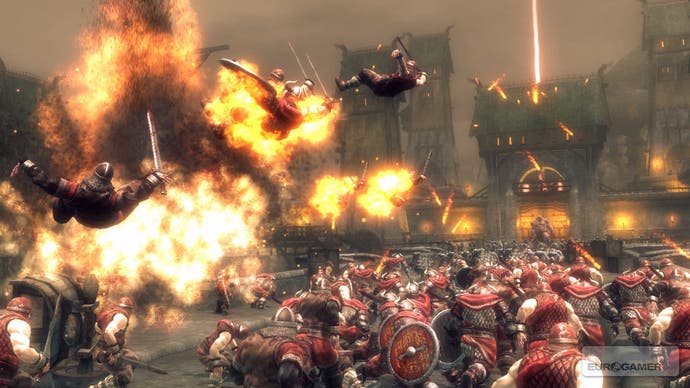Viking: Battle For Asgard
Helish.
You'll also realise that CA has rejected the standard RPG-style upgrade system, even though downed enemies still spew the red orbs we see emerging from dead creatures in every game in the genre. In Viking, these red orbs top up your magic meter, and you have the option to supplement your standard attacks with some fire, lightning or ice if you hold down the right trigger and press the corresponding face button. In terms of upgrading your abilities, that, for whatever reason, comes about by accumulating all the gold that lies inexplicably discarded in all parts of the game world. When you eventually find the battle arena, you're then given the option of buying extra combo moves - providing you can demonstrate your ability to pull them off. Curiously, improving your magic abilities is simply a financial transaction at your local market.
Being kind, you could argue that stripping things out makes the game more accessible to newcomers not schooled in the arcane ways of XP and levelling up. But if anything, forcing players to trudge around buying upgrades rather than earning them feels even more convoluted; it merely rewards players who take time to tediously scoop up discarded gold, and then makes you go to a specific part of the map to do it all.
Putting the abysmal upgrade system to one side, the real Achilles heel of the gameplay is how simplistic the combat is, with almost no substance to the move-set, which relies on simple, one-button or one-two moves sufficient to take down everyone from the most clueless grunt to the game's towering giants. Rule of thumb? Hammer the heavy attack button until they go away - the chances are, the enemy AI will be so dumb, and the collision detection so wayward, that you'll win the day almost by default. The game has a knack of making all this crazed button-mashing look very, very good, so it almost fools you into believing you're a badass, while in reality you're hardly having to do anything involving real skill. That the game lets you get away with this kind of thing on hard mode is unforgivable. Very late on in the game, you do find yourself using the dodge move a little more, but by then you'll have already long since ceased to care.

Elsewhere, the way CA handles the map endgame is curious to say the least, requiring neither combat skill nor any semblance of strategic nous. Having gone to considerable effort amassing an army and summoning a dragon to fight alongside you, you realise that the battles are harder to screw up than they are to win. This foregone conclusion involves little more than beating up one or more brainless giants (via Quick Time Events that a four-year-old would have trouble failing), running though a gaggle of enemies, and then smashing up one or more shaman. While your massed army goes about their business looking useful, you can effectively leave the dirty work to them and head straight for the strange-looking chap without a face surrounded by glowing red pillars. To send him back to wherever he came from, you have to quickly smash up these pillars, while respawning monsters try to carve you to little chunks.
But, as with the rest of the game, so long as you hammer the heavy attack button, the chances are you'll be fine - and if not, no worries, you'll respawn nearby anyway. To make it even less taxing, killing giants and shaman earns you Dragon Runes, which you can spend on sending fiery death on one of your targets. Once you've cleared the area completely, you'll eventually be able to summon your own shaman at a designated spot and bring blue skies and sunshine back to the world. Hurrah. You'd perhaps hope for some sense of achievement, but the more you play, the more you realise that you're just doing the same boring things over and over again across three increasingly large maps. Eventually, after about 16 or so hours, Creative Assembly decides that, yes, the world has been cleared of all evil, you can go now.
After that? Well, you'll be several hundred Gamerscore points richer, for what that's worth, but you're left feeling empty with zero incentive to go back and replay the game, and no multiplayer mode. You'll have hammered your way through hours of mindless, grinding hackandslash, and probably wondered why you bothered at all. The best thing you can say about the game is that it's technically impressive, and the openworld structure is a good idea - but that's it. The game's central purpose seems to be to make dismemberment as easy to pull off as possible, but as soon as that novelty has worn off you're left with a hollow, repetitive experience which quickly loses its initial appeal. With Devil May Cry 4 content to stand still, and Viking failing to build on its initial promise, it's all eyes on Tecmo and Ninja Gaiden 2 to inject some life into the hackandslash genre . For now, save your money.









